The letters in these six folders primarily cover the years 1917-1920, although there are some items from 1914-1916 and a few from 1921, 1927, 1930, and 1931. In addition to Edison and Daniels, the correspondents include their spouses, Mina Miller Edison and Addie Worth Bagley Daniels; their personal assistants, William H. Meadowcroft and Frank Smith; and longtime Edison associates Frank J. Sprague and T. Comerford Martin. The wartime correspondence, which constitutes the bulk of the collection, consists primarily of typewritten copies of Edison's incoming letters that Daniels kept in his personal file, along with carbon copies of his own outgoing letters. There are also a few items in Edison's hand. Many of the letters discuss Edison's wartime research projects for the U.S. Navy. Since a more complete set of research reports can be found in the Edison Wartime Research Reports (Charles Hummel Collection), these letters have selected only in cases where there is no copy in the Hummel Collection. Among the research projects discussed in the selected reports are Edison's sea anchor (or kite rudder) for the rapid turning of merchant ships threatened by enemy torpedoes; smoke bombs to hide merchant ships from enemy submarines; searchlights for use on U.S. submarines; and various submarine detection experiments. The letters from the summer of 1917 also discuss the difficulties experienced by Edison in securing a private yacht on which to conduct his experiments—a situation that was ultimately remedied when the Navy gave him the use of the USS Sachem.
The Daniels Papers also contains numerous letters dealing with Edison's role as chairman (later president) of the Naval Consulting Board. The original signed copy of Daniels's letter of July 7, 1915, inviting Edison to head a civilian advisory board is in the Edison National Historical Park archives. However, two earlier drafts of this letter, both dated May 31, 1915, as well as a third undated draft, with handwritten changes by Daniels, can be found in the Daniels Papers. The two typewritten drafts dated May 31 are identical except for some minor texual variations on the third and fourth pages and a few handwritten revisions by Daniels on one of the drafts. These drafts, one of which begins on Department of the Navy letterhead, were probably transcriptions made by department personnel of a letter composed on a dictating machine by Edison's chief engineer, Miller Reese Hutchison. About 75 percent of the text appears in the final version sent out on July 7. The undated draft was most likely composed by Louis Howe, the secretary to Assistant Secretary of the Navy Franklin D. Roosevelt, who frequently served as a ghost writer for Daniels. About 55 percent of the text of this draft appears in the final letter. Transcriptions of the drafts and final letter indicating which passages from the drafts were incorporated into the letter of July 7 can be found here. In all, about 48 percent of the final letter was written by Hutchison, 30 percent by Howe, and 22 percent by Daniels.
Among the topics discussed in the wartime correspondence are Edison's concern that his research be kept secret, his dissatisfaction with the career officers of the U.S. Navy, the acrimonious debate over the location and purpose of the Naval Research Laboratory, and his strenuous objection to the decision to locate the laboratory in Washington, D.C. A handwritten letter marked "personal & private," written by Edison two weeks before the end of the w
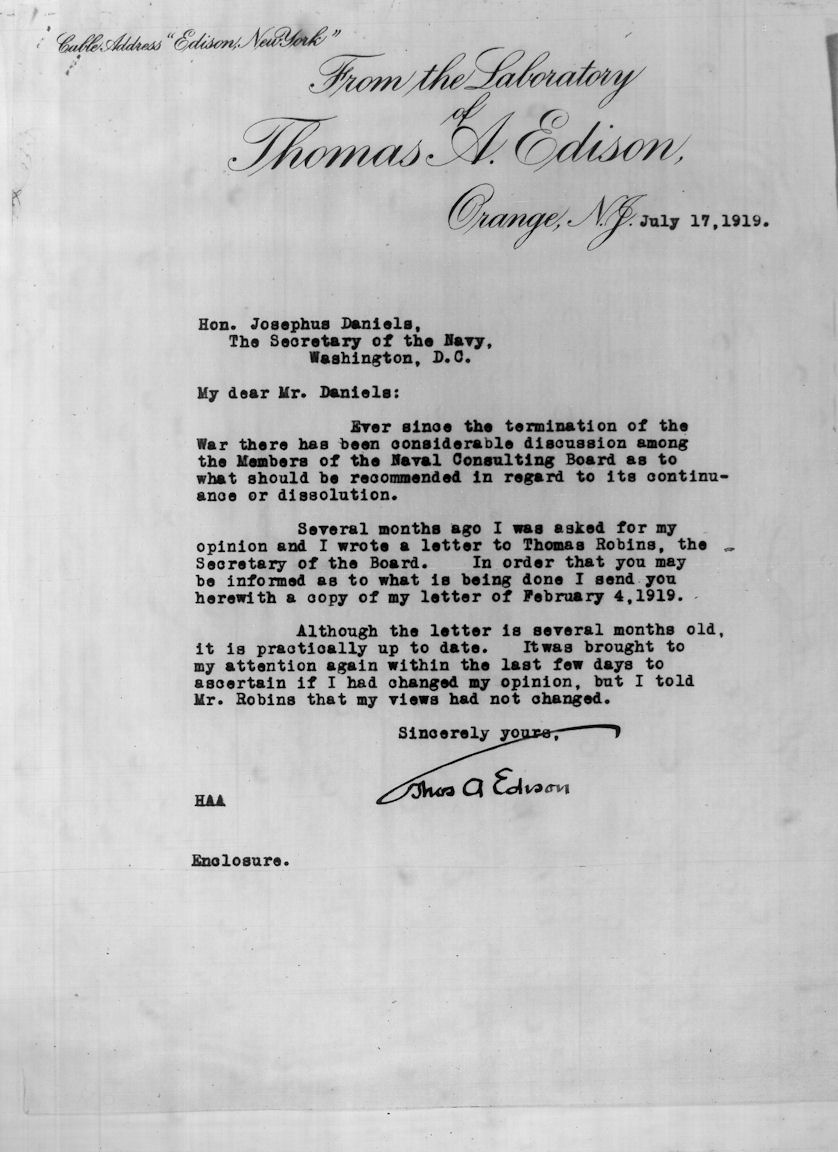 [X042G1CV], Letter from Thomas Alva Edison to Josephus Daniels, July 17th, 1919 1919-07-17
[X042G1CV], Letter from Thomas Alva Edison to Josephus Daniels, July 17th, 1919 1919-07-17 [X042G1CW], Letter from Thomas Alva Edison to Thomas Robins, February 4th, 1919 1919-02-04
[X042G1CW], Letter from Thomas Alva Edison to Thomas Robins, February 4th, 1919 1919-02-04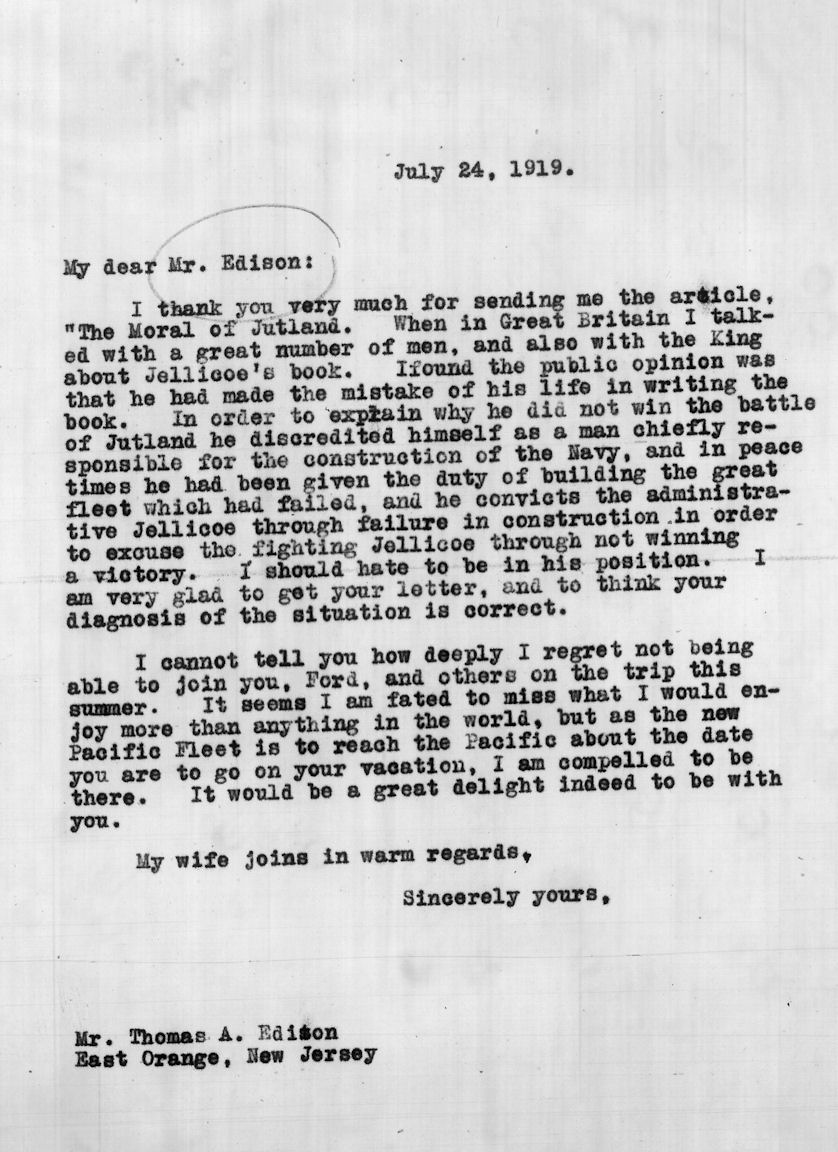 [X042G1CX], Letter from Thomas Alva Edison to Josephus Daniels, July 22nd, 1919 1919-07-22
[X042G1CX], Letter from Thomas Alva Edison to Josephus Daniels, July 22nd, 1919 1919-07-22 [X042G1CY], Letter from Josephus Daniels to Thomas Alva Edison, July 24th, 1919 1919-07-24
[X042G1CY], Letter from Josephus Daniels to Thomas Alva Edison, July 24th, 1919 1919-07-24 [X042G1CZ], Letter from Thomas Alva Edison to Josephus Daniels, July 26th, 1919 1919-07-26
[X042G1CZ], Letter from Thomas Alva Edison to Josephus Daniels, July 26th, 1919 1919-07-26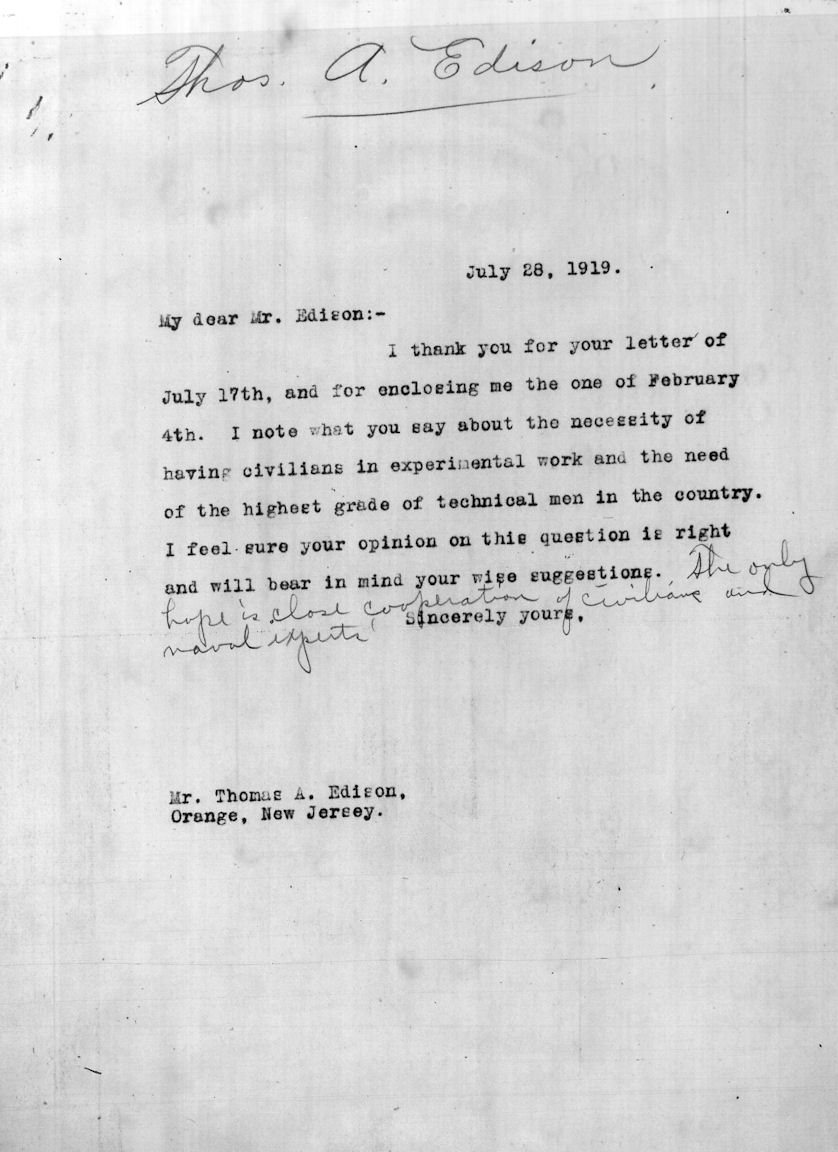 [X042G1DA], Letter from Josephus Daniels to Thomas Alva Edison, July 28th, 1919 1919-07-28
[X042G1DA], Letter from Josephus Daniels to Thomas Alva Edison, July 28th, 1919 1919-07-28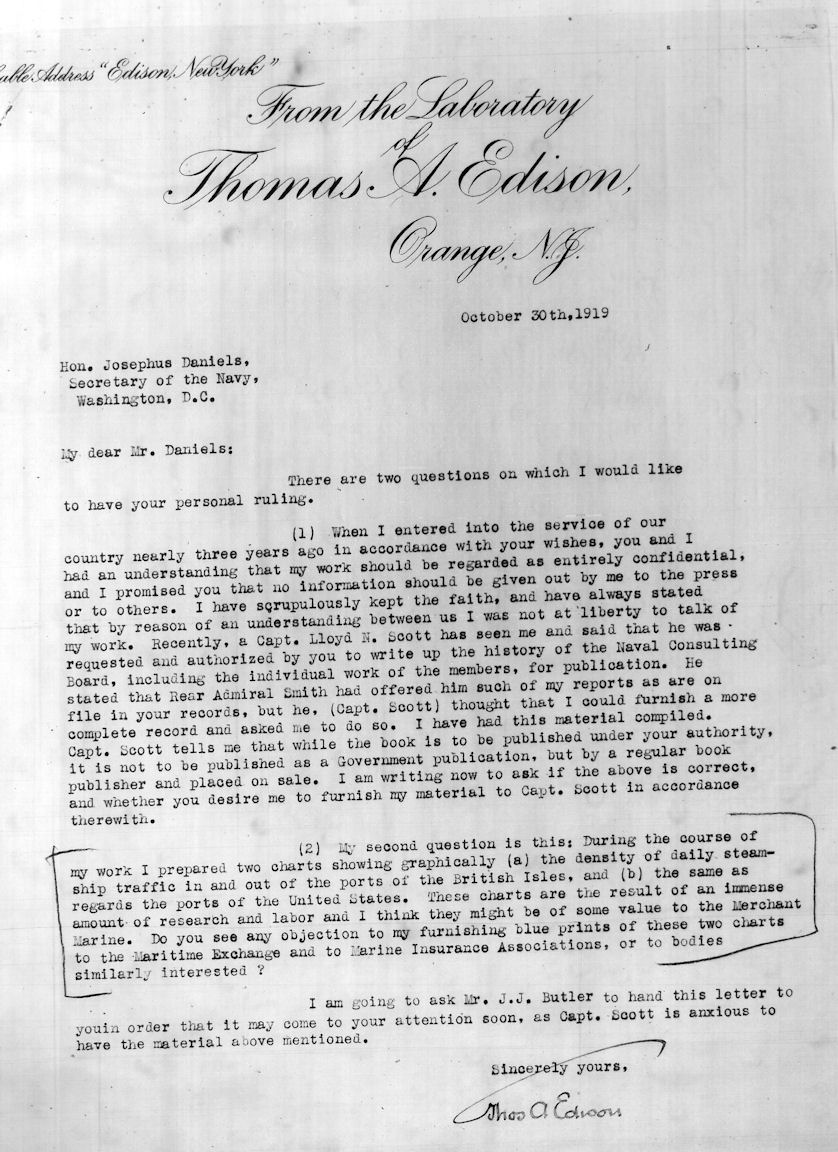 [X042G1DB], Letter from Thomas Alva Edison to Josephus Daniels, October 30th, 1919 1919-10-30
[X042G1DB], Letter from Thomas Alva Edison to Josephus Daniels, October 30th, 1919 1919-10-30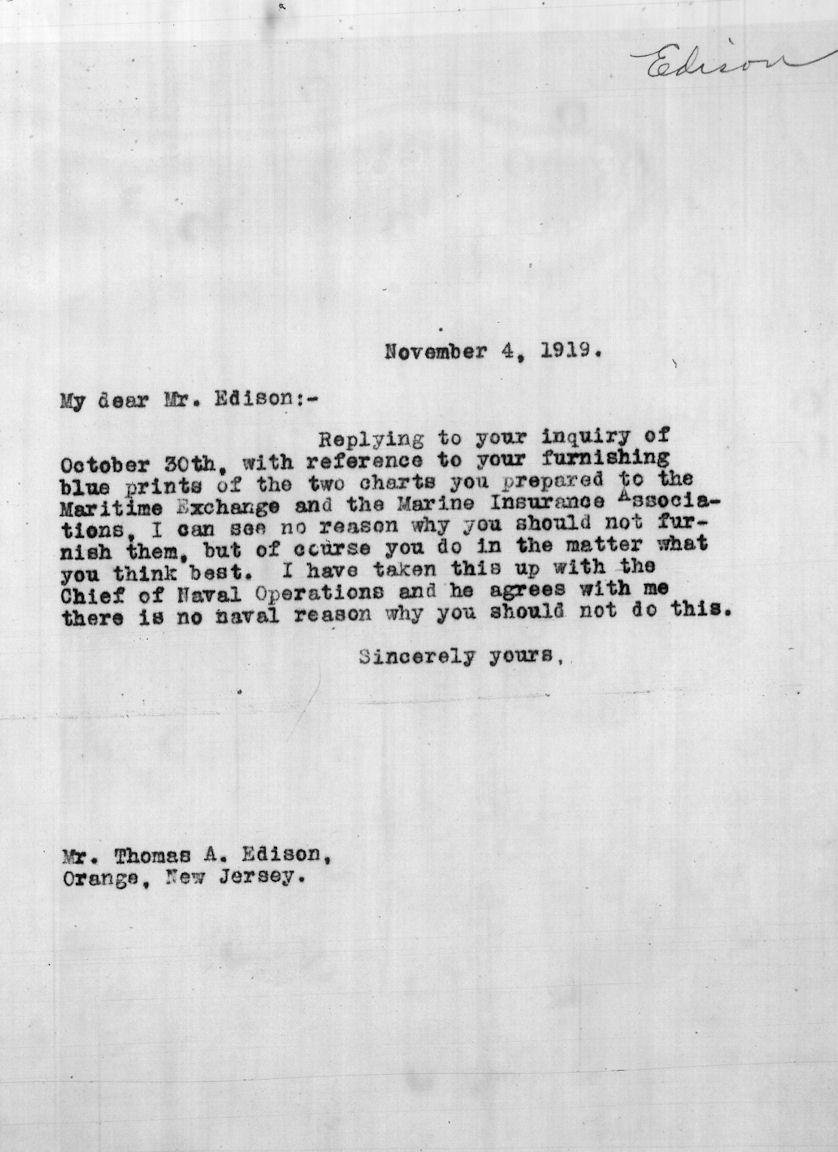 [X042G1DC], Letter from Josephus Daniels to Thomas Alva Edison, November 4th, 1919 1919-11-04
[X042G1DC], Letter from Josephus Daniels to Thomas Alva Edison, November 4th, 1919 1919-11-04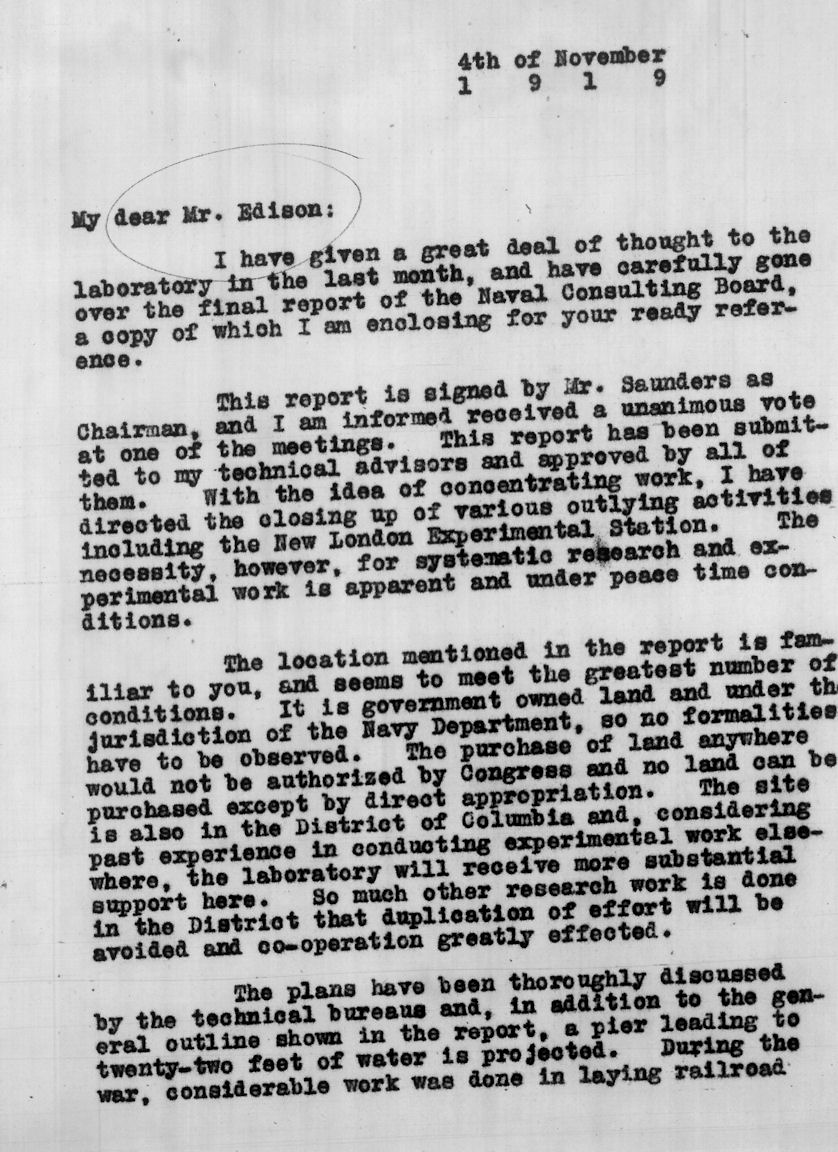 [X042G1DD], Letter from Josephus Daniels to Thomas Alva Edison, November 4th, 1919 1919-11-04
[X042G1DD], Letter from Josephus Daniels to Thomas Alva Edison, November 4th, 1919 1919-11-04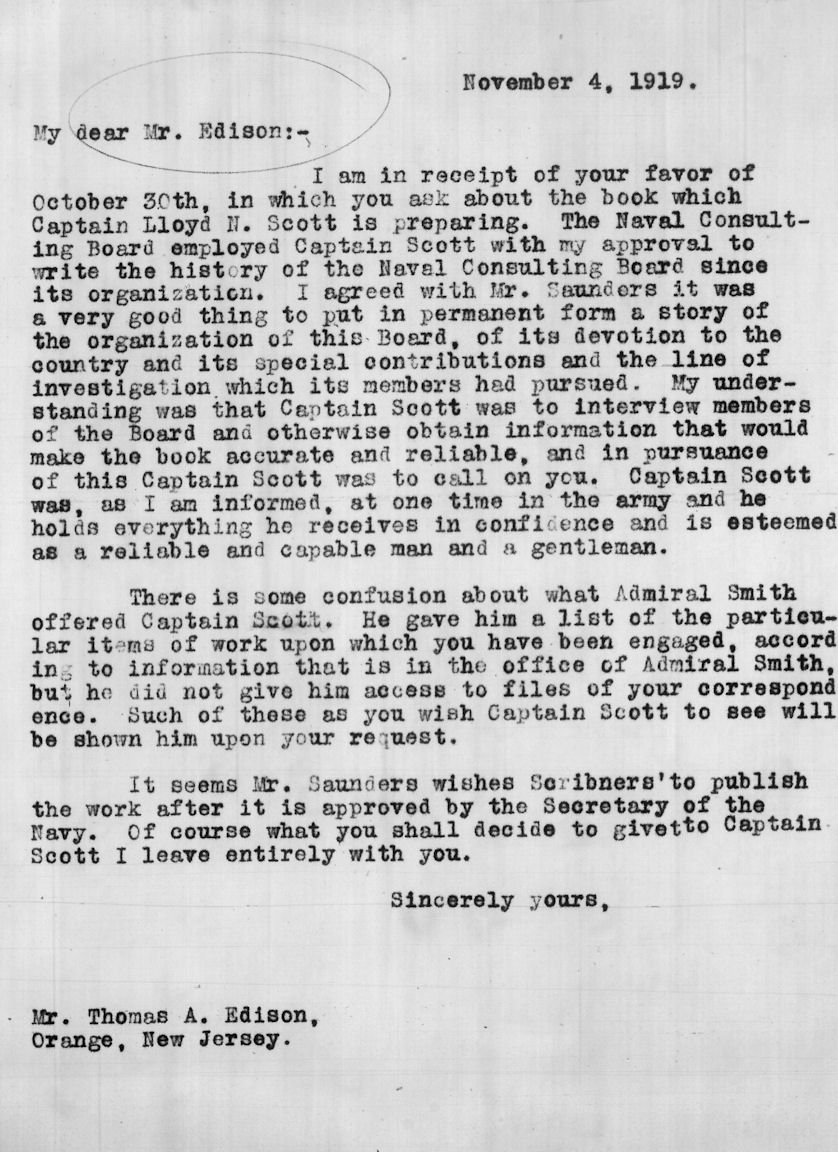 [X042G1DE], Letter from Josephus Daniels to Thomas Alva Edison, November 4th, 1919 1919-11-04
[X042G1DE], Letter from Josephus Daniels to Thomas Alva Edison, November 4th, 1919 1919-11-04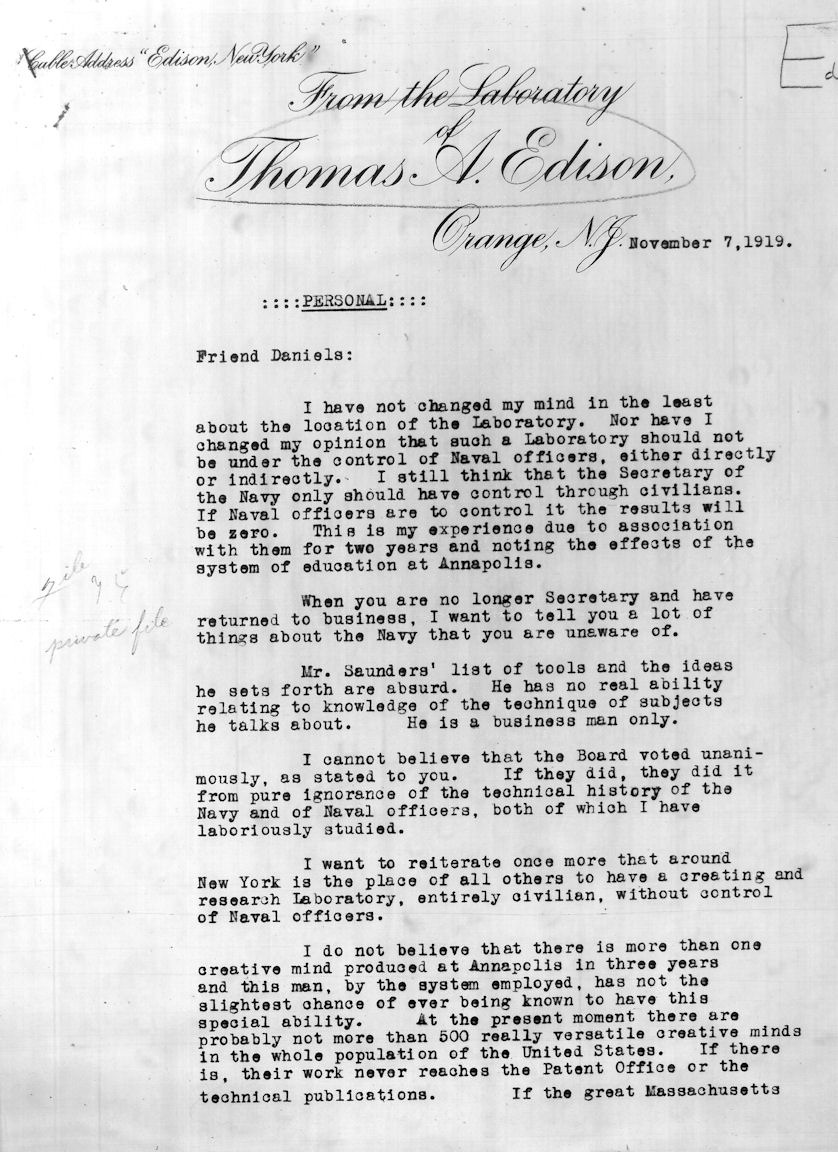 [X042G1DF], Letter from Thomas Alva Edison to Josephus Daniels, November 7th, 1919 1919-11-07
[X042G1DF], Letter from Thomas Alva Edison to Josephus Daniels, November 7th, 1919 1919-11-07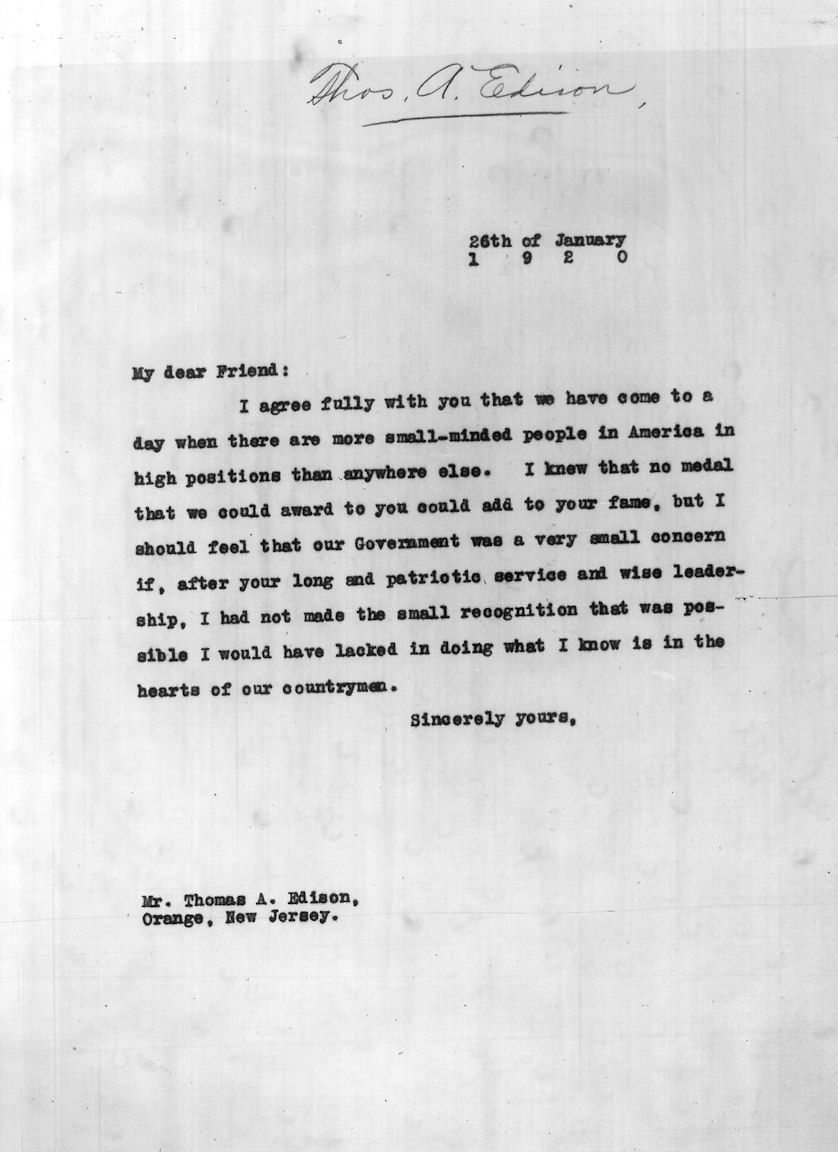 [X042G1DG], Letter from Josephus Daniels to Thomas Alva Edison, January 26th, 1920 1920-01-26
[X042G1DG], Letter from Josephus Daniels to Thomas Alva Edison, January 26th, 1920 1920-01-26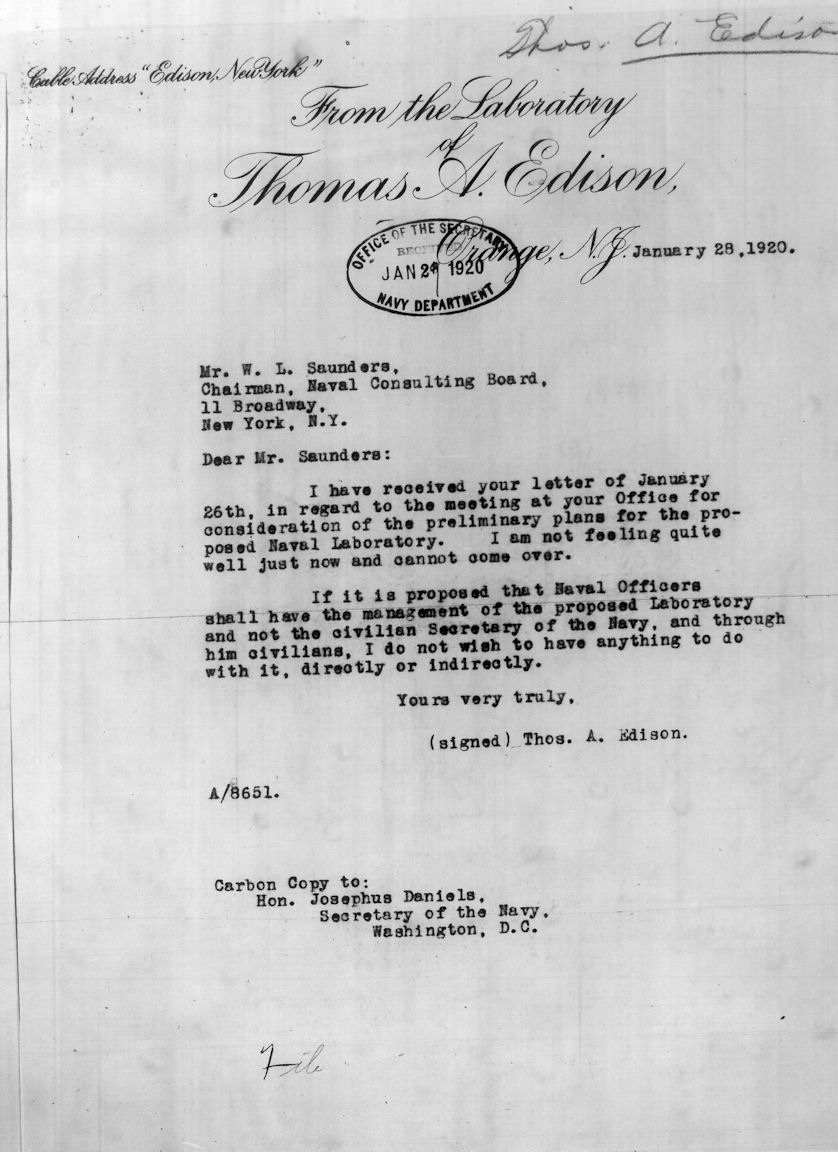 [X042G1DH], Letter from Thomas Alva Edison to William Lawrence Saunders, Naval Consulting Board, January 28th, 1920 1920-01-28
[X042G1DH], Letter from Thomas Alva Edison to William Lawrence Saunders, Naval Consulting Board, January 28th, 1920 1920-01-28 [X042G1DH1], Letter from Thomas Commerford Martin to Josephus Daniels, January 30th, 1920 1920-01-30
[X042G1DH1], Letter from Thomas Commerford Martin to Josephus Daniels, January 30th, 1920 1920-01-30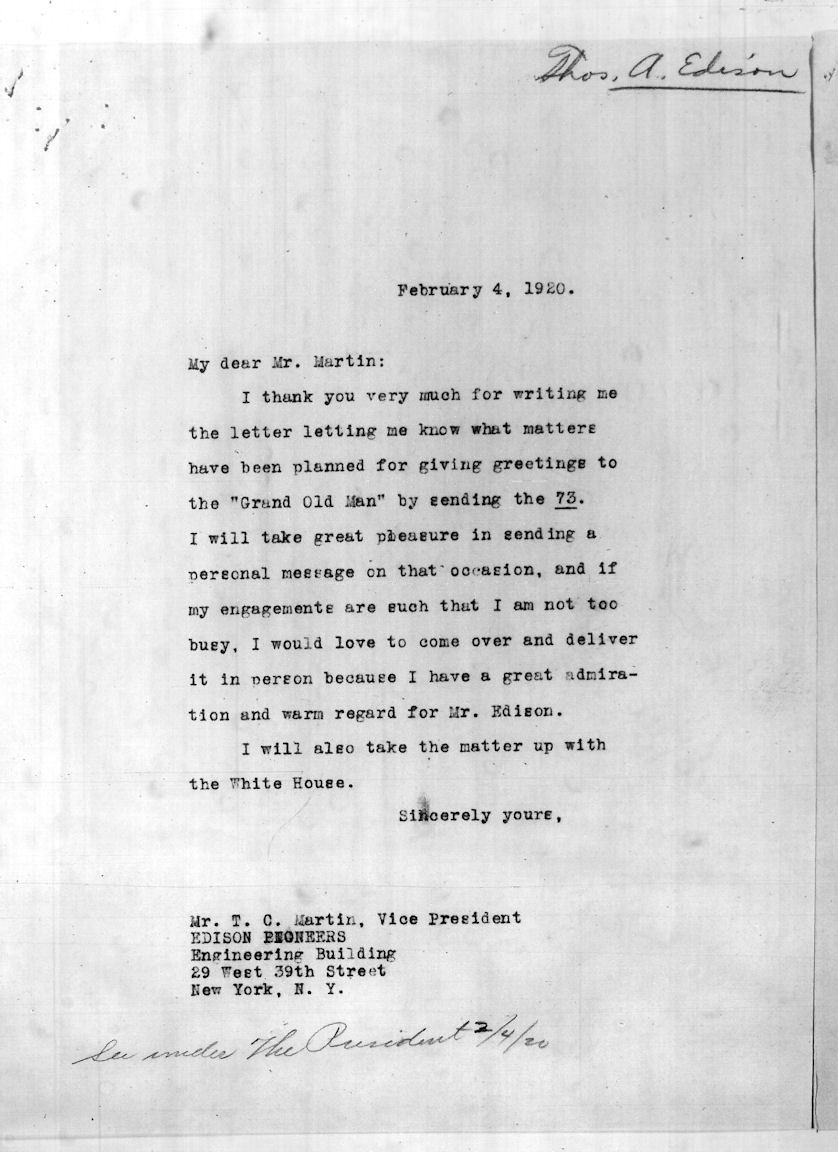 [X042G1DH2], Letter from Josephus Daniels to Thomas Commerford Martin, February 4th, 1920 1920-02-04
[X042G1DH2], Letter from Josephus Daniels to Thomas Commerford Martin, February 4th, 1920 1920-02-04 [X042G1DH3], Letter from Josephus Daniels to Thomas Commerford Martin, February 9th, 1920 1920-02-09
[X042G1DH3], Letter from Josephus Daniels to Thomas Commerford Martin, February 9th, 1920 1920-02-09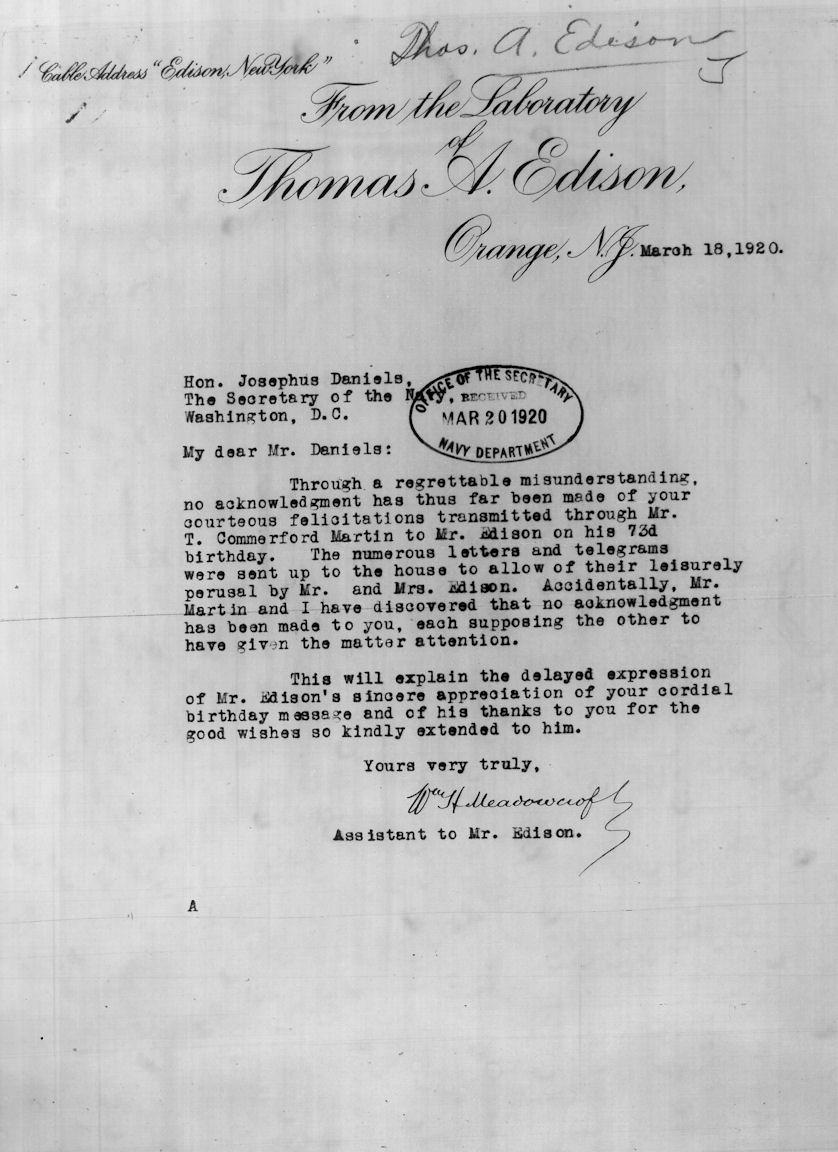 [X042G1DI], Letter from William Henry Meadowcroft to Josephus Daniels, March 18th, 1920 1920-03-18
[X042G1DI], Letter from William Henry Meadowcroft to Josephus Daniels, March 18th, 1920 1920-03-18 [X042G1DJ], Letter from Josephus Daniels to Thomas Alva Edison, June 17th, 1920 1920-06-17
[X042G1DJ], Letter from Josephus Daniels to Thomas Alva Edison, June 17th, 1920 1920-06-17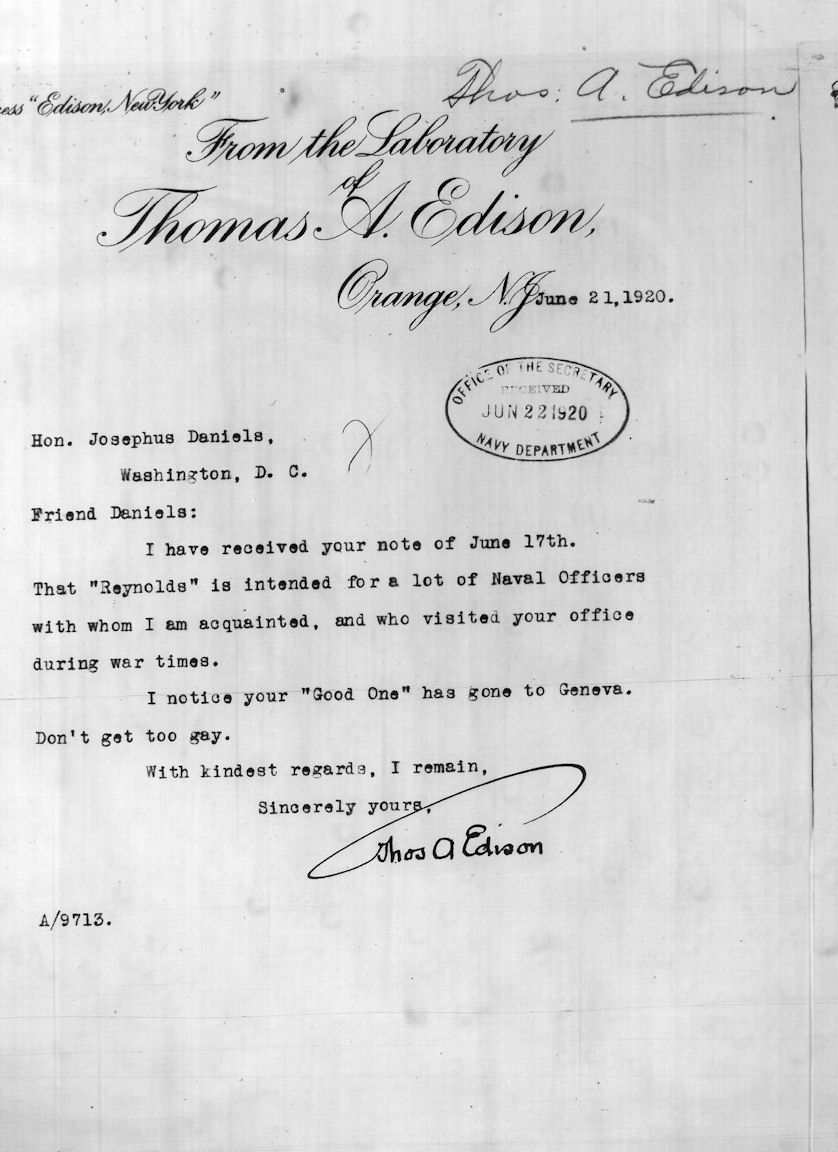 [X042G1DK], Letter from Thomas Alva Edison to Josephus Daniels, June 21st, 1920 1920-06-21
[X042G1DK], Letter from Thomas Alva Edison to Josephus Daniels, June 21st, 1920 1920-06-21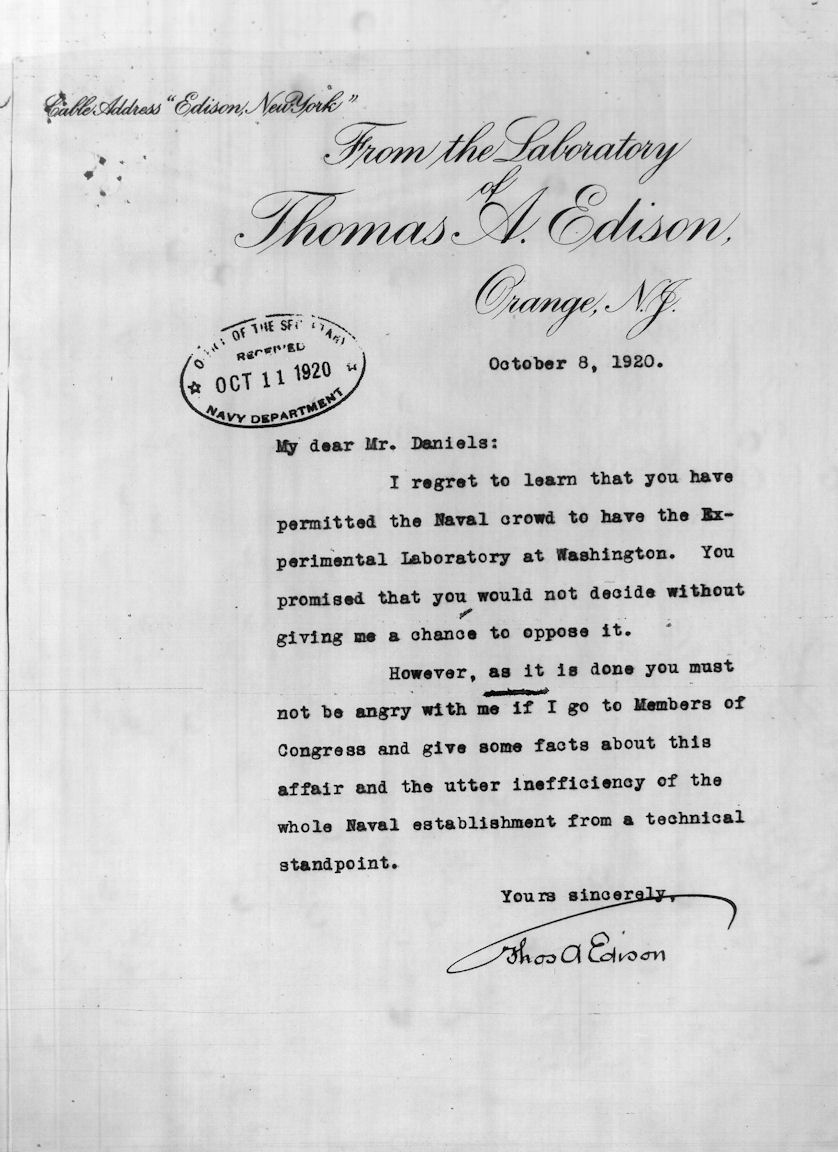 [X042G1DL], Letter from Thomas Alva Edison to Josephus Daniels, October 8th, 1920 1920-10-08
[X042G1DL], Letter from Thomas Alva Edison to Josephus Daniels, October 8th, 1920 1920-10-08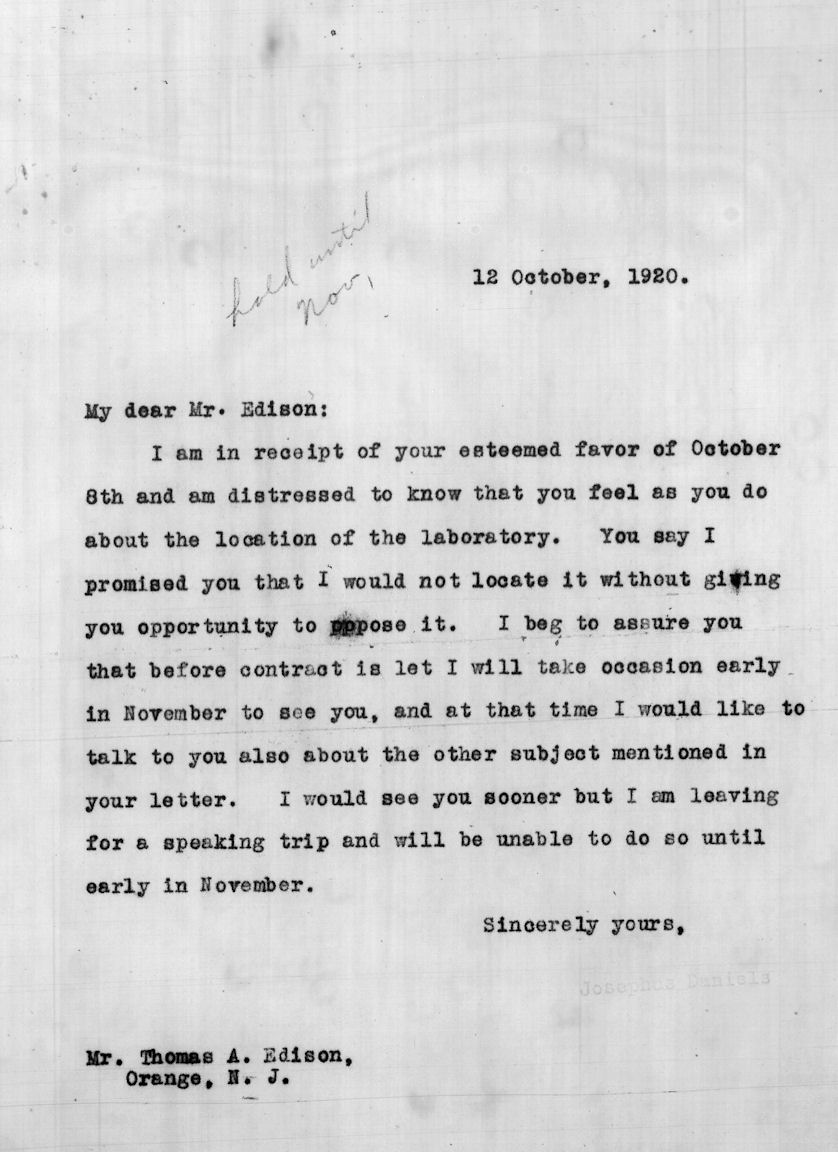 [X042G1DM], Letter from Josephus Daniels to Thomas Alva Edison, October 12th, 1920 1920-10-12
[X042G1DM], Letter from Josephus Daniels to Thomas Alva Edison, October 12th, 1920 1920-10-12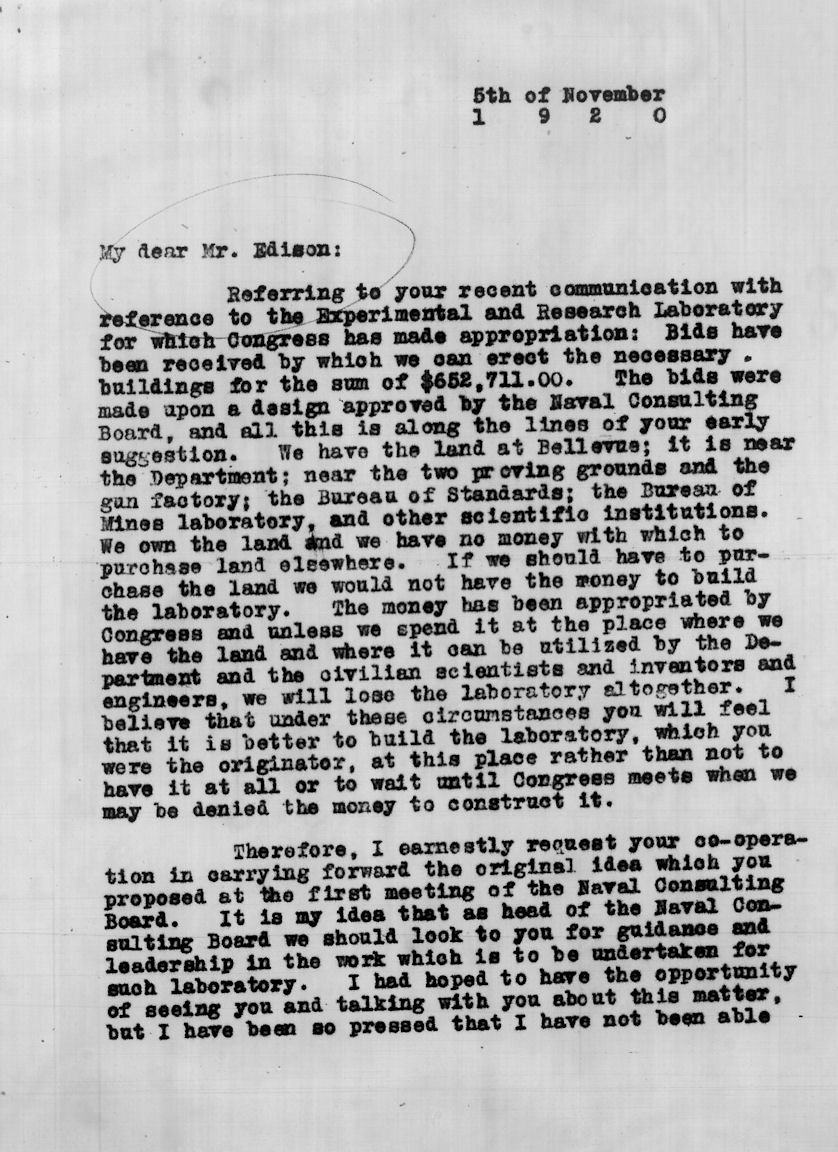 [X042G1DN], Letter from Josephus Daniels to Thomas Alva Edison, November 5th, 1920 1920-11-05
[X042G1DN], Letter from Josephus Daniels to Thomas Alva Edison, November 5th, 1920 1920-11-05 [X042G1DO], Letter from Thomas Alva Edison to Josephus Daniels, November 8th, 1920 1920-11-08
[X042G1DO], Letter from Thomas Alva Edison to Josephus Daniels, November 8th, 1920 1920-11-08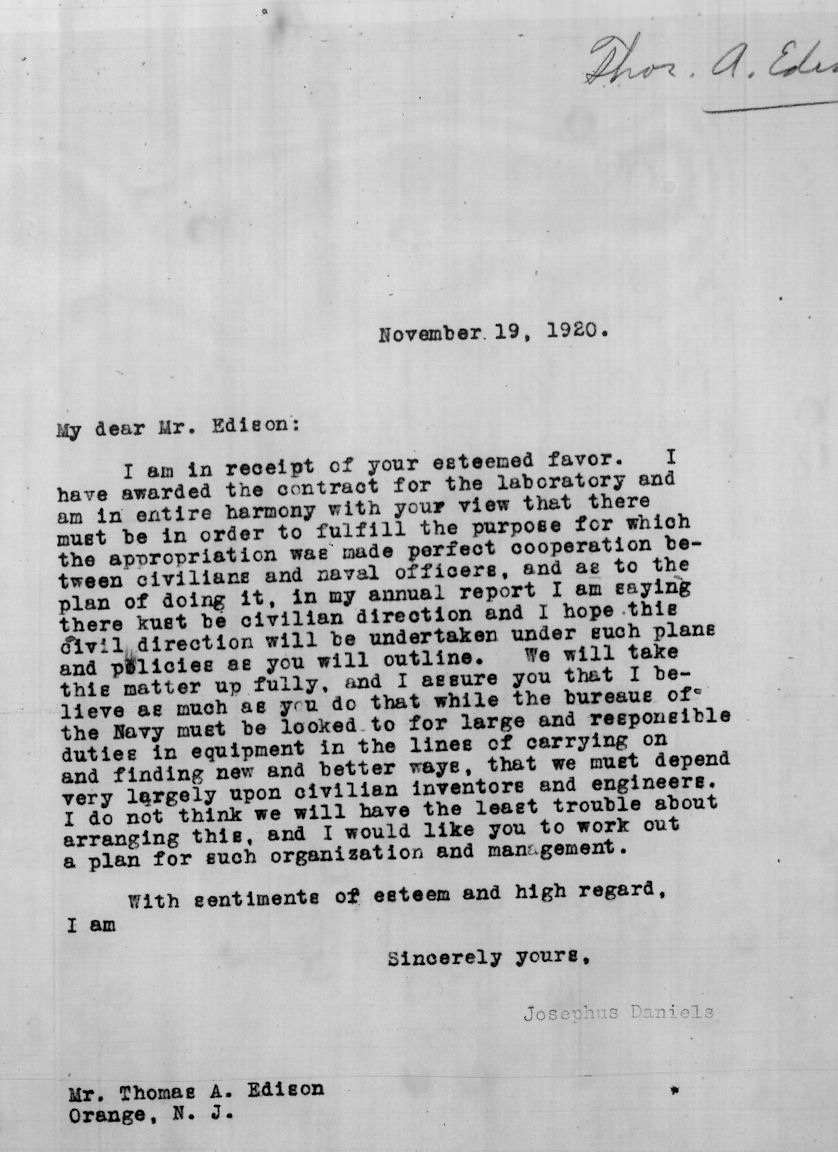 [X042G1DP], Letter from Josephus Daniels to Thomas Alva Edison, November 19th, 1920 1920-11-19
[X042G1DP], Letter from Josephus Daniels to Thomas Alva Edison, November 19th, 1920 1920-11-19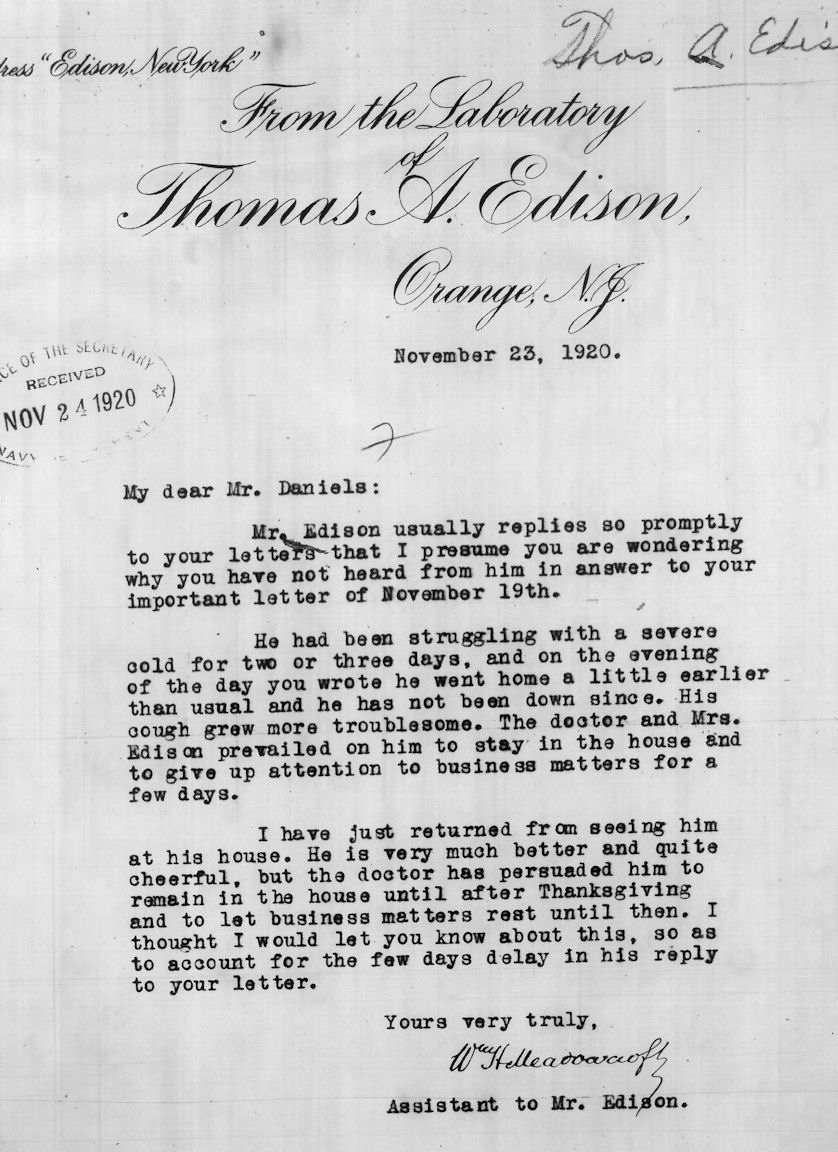 [X042G1DQ], Letter from William Henry Meadowcroft to Josephus Daniels, November 23rd, 1920 1920-11-23
[X042G1DQ], Letter from William Henry Meadowcroft to Josephus Daniels, November 23rd, 1920 1920-11-23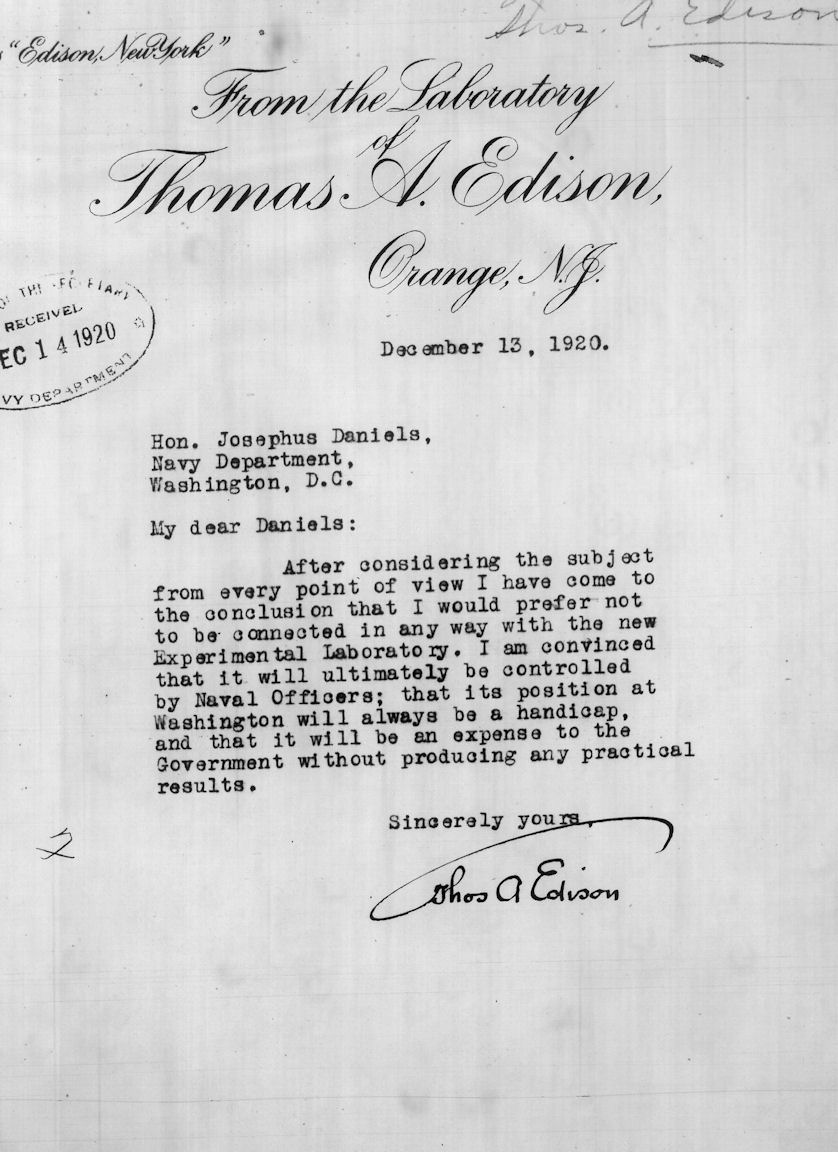 [X042G1DR], Letter from Thomas Alva Edison to Josephus Daniels, December 13th, 1920 1920-12-13
[X042G1DR], Letter from Thomas Alva Edison to Josephus Daniels, December 13th, 1920 1920-12-13 [X042G1DS], Letter from Thomas Alva Edison to Josephus Daniels, December 17th, 1920 1920-12-17
[X042G1DS], Letter from Thomas Alva Edison to Josephus Daniels, December 17th, 1920 1920-12-17 [X042G1DT], Letter from Josephus Daniels to Thomas Alva Edison, December 22nd, 1920 1920-12-22
[X042G1DT], Letter from Josephus Daniels to Thomas Alva Edison, December 22nd, 1920 1920-12-22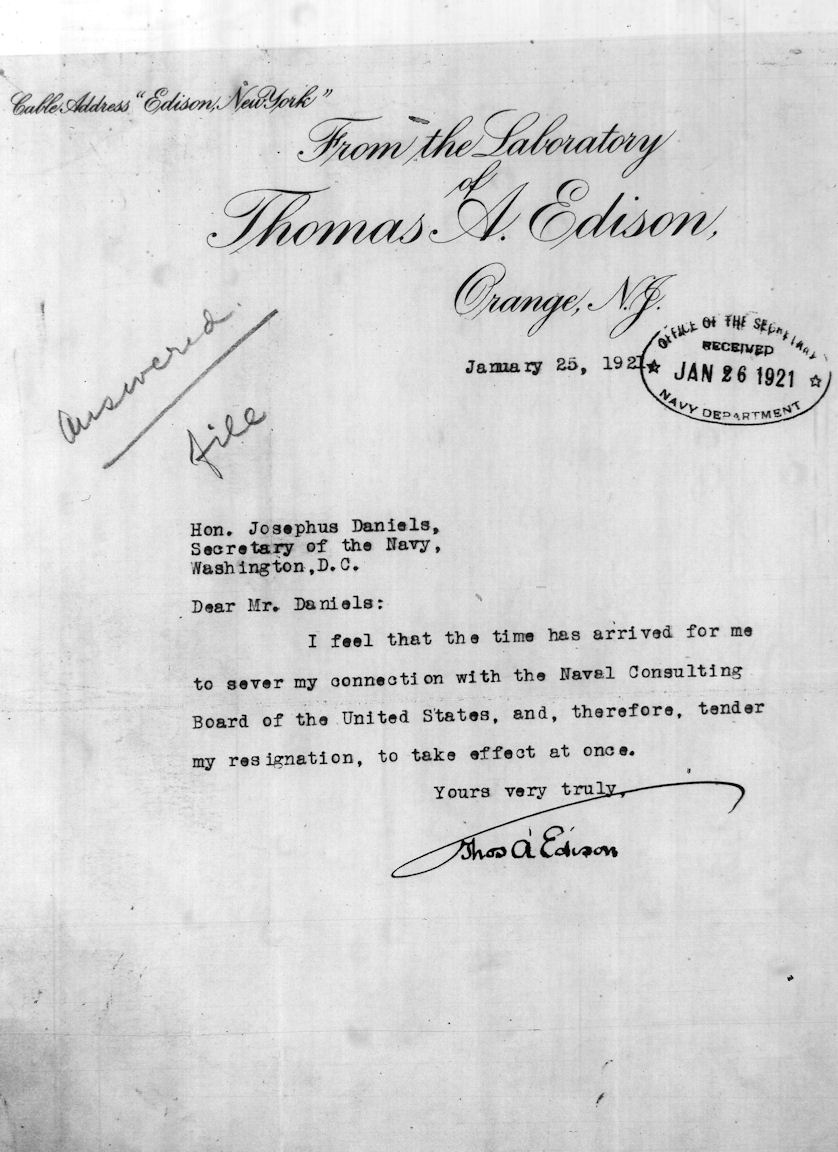 [X042G1DU], Letter from Thomas Alva Edison to Josephus Daniels, January 25th, 1921 1921-01-25
[X042G1DU], Letter from Thomas Alva Edison to Josephus Daniels, January 25th, 1921 1921-01-25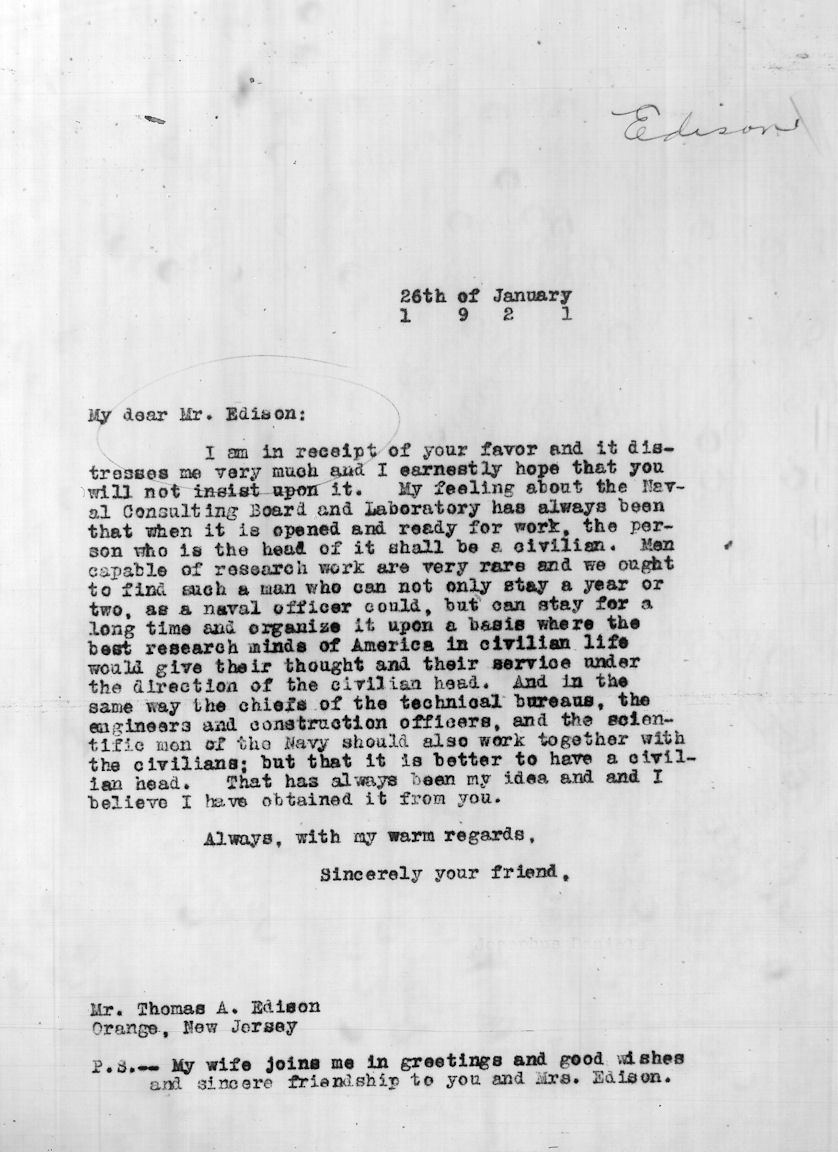 [X042G1DV], Letter from Josephus Daniels to Thomas Alva Edison, January 26th, 1921 1921-01-26
[X042G1DV], Letter from Josephus Daniels to Thomas Alva Edison, January 26th, 1921 1921-01-26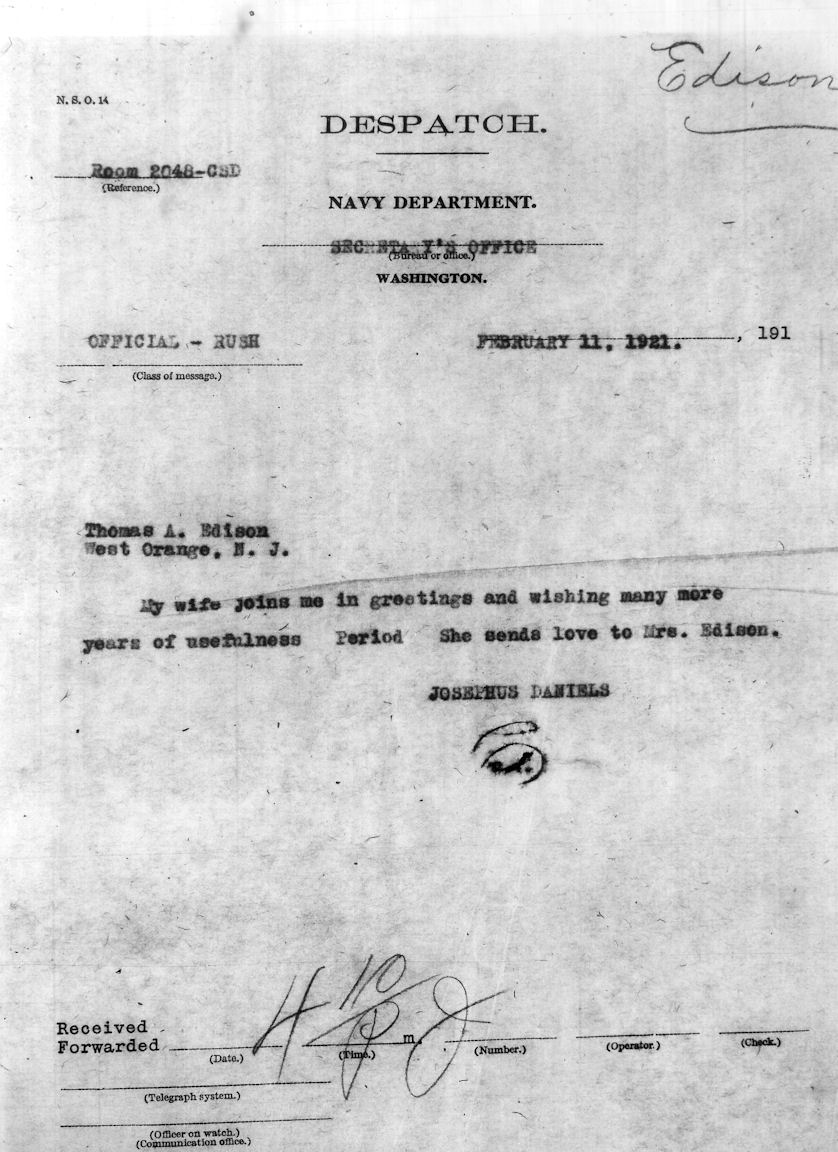 [X042G1DW], Telegram from Josephus Daniels to Thomas Alva Edison, February 11th, 1921 1921-02-11
[X042G1DW], Telegram from Josephus Daniels to Thomas Alva Edison, February 11th, 1921 1921-02-11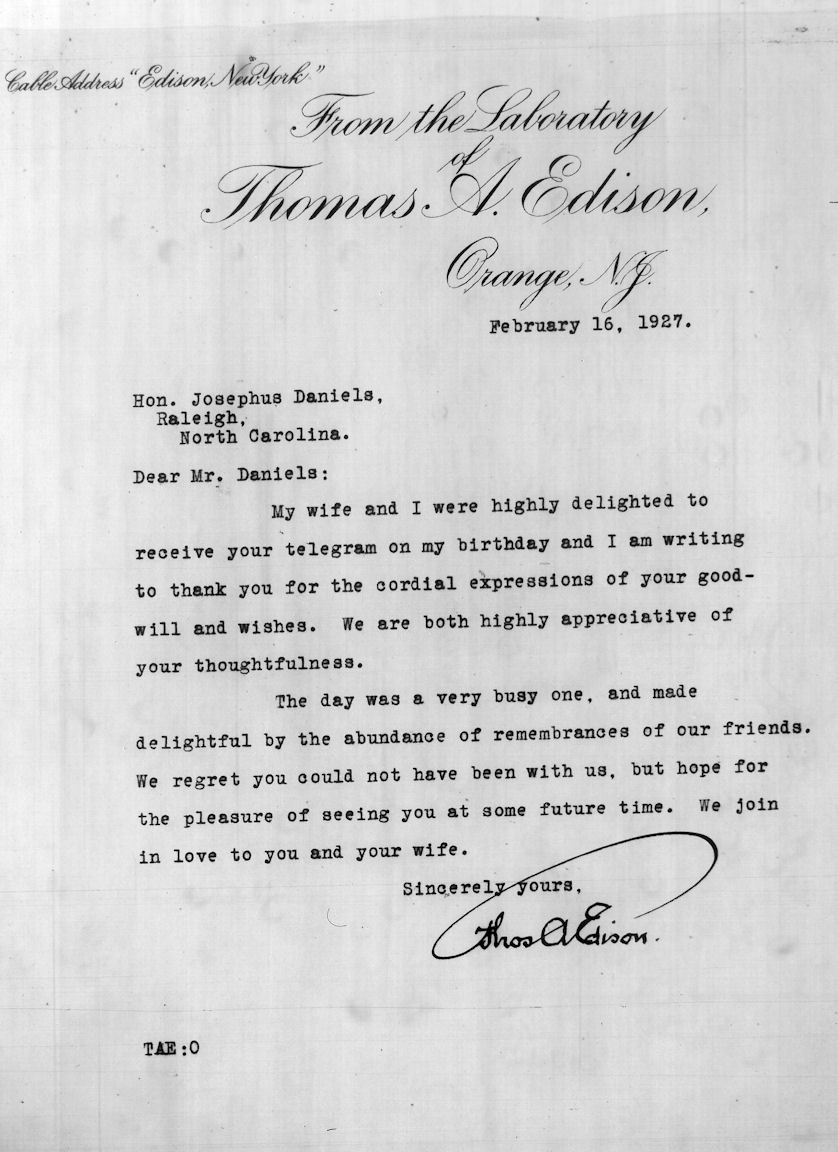 [X042G1DX], Letter from Thomas Alva Edison to Josephus Daniels, February 16th, 1927 1927-02-16
[X042G1DX], Letter from Thomas Alva Edison to Josephus Daniels, February 16th, 1927 1927-02-16 [X042G1DY], Letter from Josephus Daniels to Thomas Alva Edison, February 18th, 1927 1927-02-18
[X042G1DY], Letter from Josephus Daniels to Thomas Alva Edison, February 18th, 1927 1927-02-18 [X042G1DZ], Letter from Mina Miller (Mrs Thomas A.) Edison to Josephus Daniels, March 6th, 1927 1927-03-06
[X042G1DZ], Letter from Mina Miller (Mrs Thomas A.) Edison to Josephus Daniels, March 6th, 1927 1927-03-06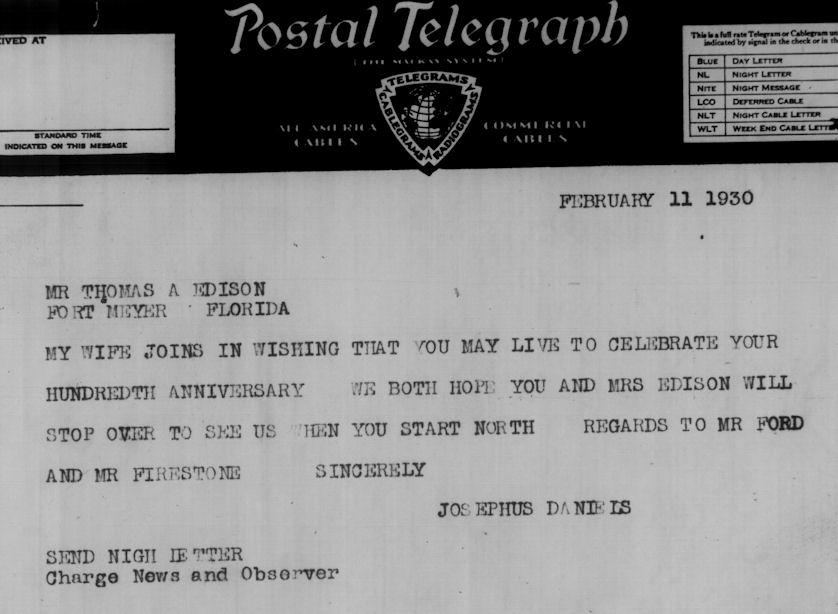 [X042G1EA], Telegram from Josephus Daniels to Thomas Alva Edison, February 11th, 1930 1930-02-11
[X042G1EA], Telegram from Josephus Daniels to Thomas Alva Edison, February 11th, 1930 1930-02-11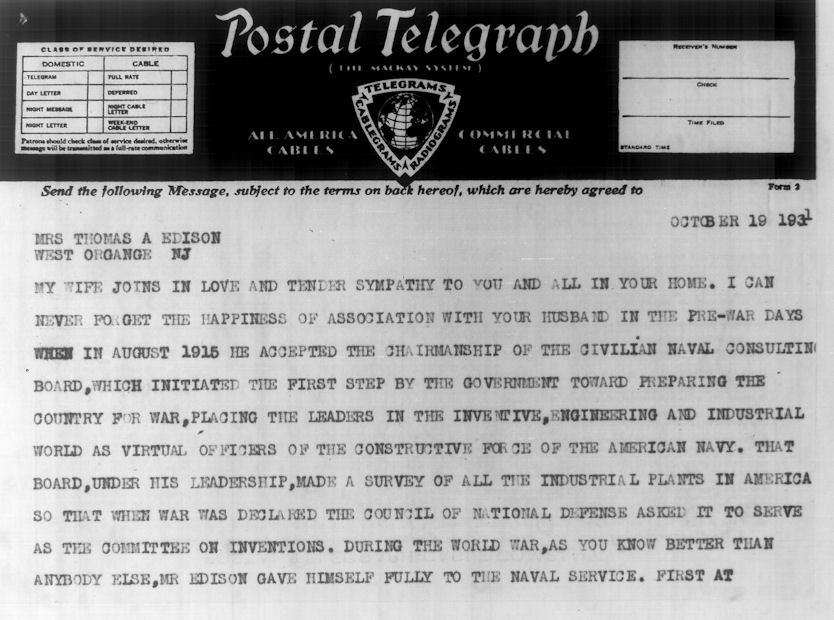 [X042G1EB], Telegram from Josephus Daniels to Mina Miller (Mrs Thomas A.) Edison, October 19th, 1931 1931-10-19
[X042G1EB], Telegram from Josephus Daniels to Mina Miller (Mrs Thomas A.) Edison, October 19th, 1931 1931-10-19